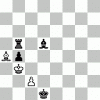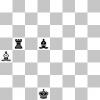-
Posts
871 -
Joined
-
Last visited
-
Days Won
7
Content Type
Profiles
Forums
Events
Gallery
Blogs
Everything posted by Prime
-
I wouldn’t classify winning with regular coins as “problem”. Just take the winnings home and measure the remaining two coins at leisure using your own precision scale. But if you insist on using the coin operated balance to the end...
-
I assume the vending machine returned all 4 deposited coins; and the balance takes one coin for each use. Good casinos give you complementary drinks when you gamble. There was no need to use vending machine for coffee.
-
-
That’s the solution! From viewpoint of chess game objective, that position may or may not make sense. But all the moves and resulting positions are legal. As far as making sense of the game... Must recognize TSLF, who apparently has solved this puzzle before and therefore abstained from posting the solution. (Posted a good hint though.)
-
That is the key to the solution. You mentioned in your previous post that Chessmaster 9 solved it for you. Or did I misunderstand? This is not a traditional chess puzzle in a sense of finding winning moves. Although, you must know the rules of the game to ensure all moves and positions are legal. In that sense it is a logical puzzle. Similar to the one I posted few years ago on this forum: which came from the same source. If there was a chess puzzle thread on this forum, I'd follow it.
-
This puzzle is from one of Martin Gardner's books: The position on the diagram occured when the White King was knocked off the board. 1. Restore the White King to the appropriate square. 2. Find the last two moves.
-
I am at loss about the purpose of "Entering singly". "Not changing one's position once taken" seems to be a reasonable, good, and severe limitation upon those criminals, indeed. Conversely, if OP requires each conman to take his place in the formation before the next inmate enters the hall, then I cannot imagine what method could possibly exist for the condemned men? After all, the rows would start forming without any knowledge of the color on the forehead of the next culprit to enter...
-
... I do have a question about one part of your disproof: If the common denominator for the first six probabilities is 66, why does the equation for P7 have a denominator of 67? Shouldn't the equation be: P7 = (65 + 7*64 + 72*63 + 73*62 + 74*6 + 75)/ 66 (Which equals my attempted answer of about .2536043952903521) If this is right, I would assume that the common denominator would cap at 66 as, eventually, all probabilities would be averages of probabilities with a 66 denominator; including P137. The disproof stands. I speculated, Bushindo's code could be something similar to the inductive step in my disproof. This problem runs deeper than it appeared at the first glance. However, our tag team solution is practical. It must be exact for any intermediate sum past infinity. And 137, as it turns out, is a hefty step towards the infinity.
-
Thanks Bonanova. My explanation does look sound. But now, after I have taken some time to reflect, I must disprove and disown my solution. Sure, the fraction that we found here is good for everyday gambling needs, but it is not the exact probability. I suspect, Bushindo’s method would have produced the exact answer, had it not succumbed to rounding error.
-
Great puzzle. Eager to see the solution. As for the blindfold, it is kept on until each captive enters the hall to prevent them from seeing the color when it is placed upon their heads and thereafter to hinder them from checking the same in the mirror of the dressing room. Hasn't Rainman already solved the puzzle? With that small modification I added, so that his solution does not rely on the preset place where to form rows.
-
It seems to stand the reason...
-
A finishing touch... Armed with this knowledge, you could make a bet, whereby first your opponent sets up any position and then you choose who moves first.
-
I don't see the OP requiring each prisoner to assume his position before the next one enters the room. So why should we be adding such a restriction? On the other hand, the OP never specified that the place for each row has been marked with like colored chairs, tile, or in any other way. Thus we must not assume that it has. Given the above, Rainman's method needs just a slight modification. As for the blindfold, it is kept on until each captive enters the hall to prevent them from seeing the color when it is placed upon their heads and thereafter to hinder them from checking the same in the mirror of the dressing room.
-
Interestingly enough, the XOR formula inhabits this game, like it does Nim. Consider a bit more complex variation: two copper coins on the left, followed by gold coin, followed by two more copper coins.
-
Good tangential thinking. But it does not work per OP. You can't claim the prize, lest you pass the test. Sure, given 100 dowries, you may not need the job. However, the participating women would not be interested.
-
That is a neat solution! Mine is a lot messier than that. The formulas could use some explaining... On the other hand, there is still a little bit of puzzle left for those who can’t invest a lot of time into solving this problem from scratch. Check out the two equations by Bushindo and figure out the precise reasoning for their construction. (Note: some people are more used to the nCk notation for combination.) There is also a general solution already mentioned by Vistaptb, which may be guessed at by the actual answers found by Bushindo. People who like calculus may want to tackle that aspect of the problem. Honorable mention to Rainman for also finding the right idea. As for the problem of finding the largest number where the distribution is known suggested here by Caliban27 and Bonanova -- that's a different one. I never got around to working on it, so I will not start a new topic, though deserving it may be. I agree with Bonanova about the social implications of such problem. The problem presented here has a great value for young people in making their real life choices, as well.
-
The range of dowry amounts is unknown. There is no average, no deviation.
-
I did stipulate that it would be fun to solve if you haven't encountered a similar problem before. If you remember seeing such problem but have forgotten the solution (as seems to be the case,) it could be fun to derive and prove it over again.
-
This is a bit more difficult probability puzzle. Old classics, fun to solve, if you haven’t encountered a similar problem before. As a young aspiring Chief Statistician at the King’s Court, you are presented with this challenge. You must select a bride with the largest dowry. (Being married is a requirement for the Chief Statistician position.) Wherefore, you must choose from 100 equally beautiful young females with a weakness for only the smartest of statisticians, where each bride’s family offers a different dowry. The $ amount of each dowry is written on the backside of the girl’s personal card. Those amounts are presented to you one at a time in random order. When an amount is presented to you, you may either reject it, or settle for it. When you reject a dowry, you are presented the next card. If you fail to choose the dowry, which is the largest among 100, then you loose both your chance for the Court position and your right to claim your bride. What strategy can you develop to maximize your chance for the position and the wealthy bride? What is the best chance? (Obviously, the dowries are presented to you just once -- no chance of going back to the amount you’ve rejected. The range of the dowries is unknown.)
-

4 unknown coins - another weighing puzzle
Prime replied to k-man's question in New Logic/Math Puzzles
This is Sort problem. Computer scientists have been tackling this very puzzle for the past 60 years or so, producing a great variety of algorithms. What you have suggested here seems like “Tree Sort” with self-balancing binary tree. The "worst case" order for such algorithm is O(n log n). That's as fast as it gets. Or, at least, that’s the present day theory. -
The analytical solution for the probability of win for each hand is as following: 1st hand = .342538484 2nd hand = .318676316 3rd hand = .338785200 A recursive program, which would traverse the entire game for 3 hands, would be simple enough to code. However, I did not chance it fearing unmanageable number of iterations. After all, given the infinite deck, a single hand in this game can be as large as 18 cards. Instead of writing a program, I built a spreadsheet table with probabilities of win/bust/continue for a single player for each round. From that probabilities of winning a “sudden death game” for each seat among 3 players may be derived. It’s a tedious solution, but I had some similar tables from my own projects with BJ probabilities, so it did not take too much of my time. I could not see any simple and elegant solution, which would avoid calculating actual probabilities. Some more trivia from the table if you play this game without partners, by your lonesome: Probability to bust = .621058 Probability to get 21 = .159379 Probability to get 20 = .219563 Probability to finish the game with a hand of 6 cards or less = .996315
-
More elegantly, Ethan could relay his wishes to Violet like so: “Would I be lying if I said, wanted steak for dinner?”
-
Do you mean that for asking questions rather than making statements, Questioners must develop a nested question convention? Does the question: “Is X=1?” asked by A establish the value for X, whereas the same question asked by B leaves the true value of X wide open? Therefore, is it important to be aware of the type of the person that you converse with? Was the question in the OP a way of introduction advising Bonanova of the true orientation of his new acquaintances? Why everyone here chooses type “A” for their own identity? (Oops, that was an illegal question.)



